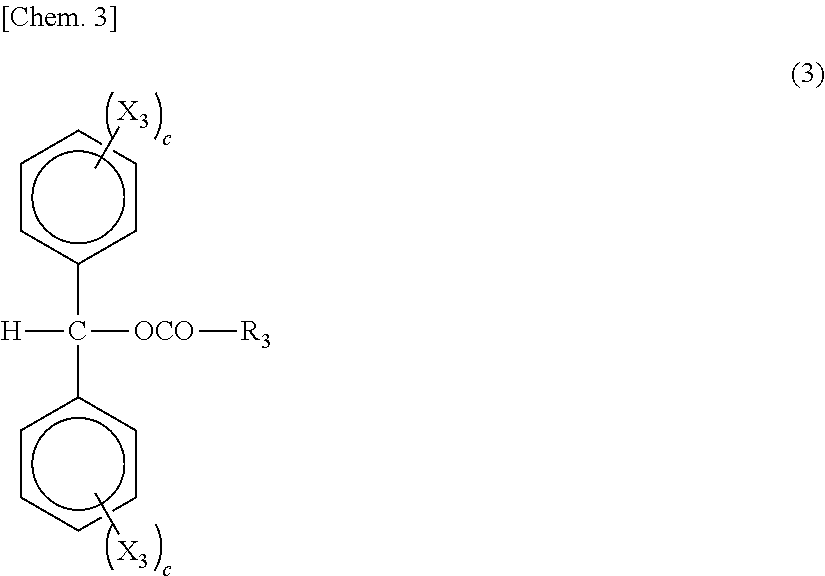Solid writing material
a writing material and composition technology, applied in the field of solid writing materials, can solve the problems of color change performance, adverse effects on the amount of filler, and the coating material technology described in the patent literature publications is difficult to apply to a solid writing material that uses a reversibly thermochromic composition in a simple manner, so as to enhance the light resistance of a solid writing material, the effect of enhancing the light resistance and not reducing strength
- Summary
- Abstract
- Description
- Claims
- Application Information
AI Technical Summary
Benefits of technology
Problems solved by technology
Method used
Image
Examples
example 101
Production of Kneaded Material of Inner Core Usable for Writing
[0142]Microcapsuled pigment A 40 parts by mass
Polyolefin wax 10 parts by mass
(SANWAX 131-P, softening point 110° C., penetration 3.5, made by Sanyo Chemical Industries, Ltd.)
Sucrose fatty acid ester 10 parts by mass
(RYOTO Sugar Ester P-170, made by Mitsubishi-Kagaku Foods Corporation)
Poly(vinyl alcohol) 2 parts by mass
Talc 38 parts by mass
The above composition was kneaded with a kneader to obtain a kneaded material for an inner core usable for writing.
(Production of Kneaded Material of Outer Shell)
[0143]Talc (filler) 80 parts by mass
Poly(vinyl alcohol) 10 parts by mass
Polyolefin wax 5 parts by mass
(SANWAX 131-P, softening point 110° C., penetration 3.5, made by Sanyo Chemical Industries, Ltd.)
Sucrose fatty acid ester 5 parts by mass
(RYOTO Sugar Ester P-170, made by Mitsubishi-Kagaku Foods Corporation)
[0144]The above composition was kneaded with a kneader to obtain a kneaded material for an outer shell.
(Production of Soli...
examples 102 to 118
[0146]Solid writing materials were yielded by the same method as in Example 101 according to the compositions shown in Table 1.
examples 201 to 219
, Comparative Examples 201 to 203
[0157]Each material was blended at a ratio shown in Table 2-1 and Table 2-2 and solid writing materials of Examples 201 to 219 and Comparative Examples 201 to 203 were obtained by the same method as in Example 101.
[0158]Solid writing materials produced in Examples 201 to 219 and Comparative Examples 201 to 203 were evaluated in terms of affinity, impact resistance, moldability and bending strength thereof according to the following method. The obtained results were as shown in Table 2-1 and 2-2.
(1) Affinity: A solid writing material was examined visually, and further, after applying a torsional stress, the degree of breakage was visually observed for rating the affinity between an outer shell and an inner core.
A: Affinity is excellent because a crack or marginal crack is not recognized.
B: Affinity is good, although some marginal cracks are recognized.
C: Affinity is practically acceptable, although some marginal cracks are recognized.
D: Affinity is in...
PUM
| Property | Measurement | Unit |
|---|---|---|
| Young's modulus | aaaaa | aaaaa |
| Young's modulus | aaaaa | aaaaa |
| melting point | aaaaa | aaaaa |
Abstract
Description
Claims
Application Information
 Login to View More
Login to View More - R&D
- Intellectual Property
- Life Sciences
- Materials
- Tech Scout
- Unparalleled Data Quality
- Higher Quality Content
- 60% Fewer Hallucinations
Browse by: Latest US Patents, China's latest patents, Technical Efficacy Thesaurus, Application Domain, Technology Topic, Popular Technical Reports.
© 2025 PatSnap. All rights reserved.Legal|Privacy policy|Modern Slavery Act Transparency Statement|Sitemap|About US| Contact US: help@patsnap.com



